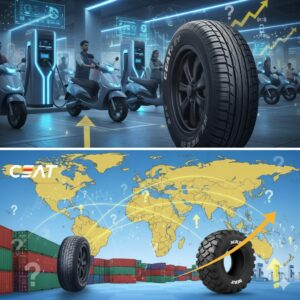Summary
The BCG Matrix of CEAT Tyres provides a comprehensive strategic analysis of how one of India’s most trusted tyre manufacturers manages its diverse product portfolio and market presence. The Boston Consulting Group (BCG) Matrix, also known as the Growth-Share Matrix, helps evaluate CEAT’s business units and product lines based on market growth rate and relative market share.
This detailed study examines how CEAT’s different tyre segments—such as two-wheeler tyres, passenger car tyres, truck and bus radial tyres, and off-road tyres—fit within the four quadrants of the BCG Matrix: Stars, Cash Cows, Question Marks, and Dogs. By doing so, it highlights how CEAT allocates resources, sustains profitability, and prepares for long-term growth in the highly competitive tyre industry.
The BCG Matrix of CEAT Tyres (2025) offers an in-depth look into how the company balances innovation, sustainability, and global expansion while maintaining a strong foothold in the Indian automotive market.
CEAT Limited, established in 1958, is one of India’s leading tyre manufacturers and a part of the RPG Group. Over the years, CEAT has built a strong brand identity rooted in trust, performance, and innovation. The company manufactures tyres for a wide range of vehicles, including two-wheelers, passenger cars, light commercial vehicles (LCVs), trucks, buses, and off-road applications.
CEAT’s commitment to quality and technological advancement has made it a significant player not only in India but also in over 110 countries worldwide. With manufacturing facilities in Mumbai, Nashik, Halol, and Nagpur, CEAT combines efficiency and sustainability in its operations.
In a rapidly evolving automotive sector driven by electric mobility, digital transformation, and environmental consciousness, strategic decision-making is key. The BCG Matrix of CEAT Tyres provides an analytical lens to understand which business areas are leading growth, which ensure financial stability, and which need strategic focus or restructuring.
What is the BCG Matrix
The Boston Consulting Group (BCG) Matrix is a strategic management framework that helps organizations analyze their business units or product lines based on two key parameters:
- Market Growth Rate: Indicates the potential and attractiveness of the market in which the product operates.
- Relative Market Share: Measures a company’s strength or competitiveness compared to its largest competitor in that market.
These two factors form a matrix divided into four quadrants:
Stars: Business units or products with high market share in high-growth markets.
Cash Cows: Products with high market share in low-growth markets that generate consistent cash flow.
Question Marks: Products with low market share in high-growth markets that have potential but need investment.
Dogs: Products with low market share in low-growth markets with limited profitability.
For a diversified manufacturer like CEAT, this matrix helps determine how to allocate resources, invest in innovation, and maintain profitability across its tyre segments.
Importance of the BCG Matrix for CEAT Tyres
The BCG Matrix plays a crucial role in CEAT’s long-term strategic planning. It enables the company to assess its position in various product categories and make informed business decisions.
Strategic Resource Allocation
By identifying high-potential areas, CEAT can allocate capital effectively, ensuring maximum returns from its investments.
Portfolio Management
The matrix helps balance between mature, revenue-generating products and emerging, high-growth categories.
Innovation and Market Development
CEAT can identify segments where product innovation, marketing, and research are most needed.
Risk Management
Maintaining a mix of Stars, Cash Cows, Question Marks, and Dogs ensures that risks from one segment are offset by profits from another.
Long-Term Growth Planning
The BCG Matrix helps CEAT align its operations with long-term sustainability and competitive advantage, especially in emerging areas like electric vehicle (EV) tyres and smart tyre technologies.
Detailed BCG Matrix Analysis of CEAT Tyres
Stars (High Market Share, High Market Growth)

Two-Wheeler Tyres
CEAT is one of the top tyre manufacturers for two-wheelers in India, catering to leading brands like Bajaj, Hero MotoCorp, TVS, and Royal Enfield. The demand for two-wheeler tyres remains strong due to India’s massive commuter market and the rising preference for personal mobility.
In recent years, CEAT has gained considerable market share in this segment by introducing innovative products such as CEAT Zoom Rad, CEAT Milaze, and CEAT Zoom Cruz, which focus on durability, fuel efficiency, and superior grip.
Additionally, CEAT’s collaboration with EV manufacturers for electric two-wheeler tyres has positioned it strongly in a rapidly growing niche. The increasing demand for replacement tyres also contributes significantly to its revenue.
Given the combination of high growth and dominant market share, the two-wheeler tyre division stands as a Star in the CEAT BCG Matrix.
Passenger Car Tyres (PCR Segment)
The passenger car segment has seen accelerated growth driven by the rise in automobile sales, improved road infrastructure, and a shift towards premium and radial tyres. CEAT’s strong presence in this segment, supported by partnerships with Maruti Suzuki, Hyundai, and Tata Motors, has boosted its market share.
CEAT’s radial tyres and high-performance series like CEAT SecuraDrive and CEAT SportDrive have become popular for their safety, comfort, and efficiency. The ongoing shift toward electric cars has also opened new avenues for CEAT to innovate with energy-efficient and low-noise tyres.
As a result, the passenger car tyre business represents another Star, reflecting CEAT’s leadership in a rapidly growing market.
Cash Cows (High Market Share, Low Market Growth)

Truck and Bus Radial Tyres (TBR Segment)
CEAT holds a solid market share in the truck and bus segment, supplying tyres to both OEMs (Original Equipment Manufacturers) and the replacement market. The segment, while profitable, has reached a mature stage with moderate growth rates.
The TBR market is dominated by established players such as MRF, Apollo Tyres, and JK Tyres, and CEAT competes effectively through quality and affordability. Its Halol plant, dedicated to radial tyres, has enhanced production capacity and cost efficiency.
Despite the slow market growth, consistent demand for commercial transport ensures steady cash flow. This division serves as a Cash Cow that supports investments in other high-growth areas such as EV tyres and export markets.
Off-Road and Specialty Tyres
CEAT’s Off-Highway Tyres (OHT) cater to agriculture, mining, and construction industries. These tyres are known for durability and strength under extreme conditions.
Although this segment’s growth is relatively slower compared to consumer tyres, CEAT maintains a strong market position with reliable demand from industrial clients. The OHT segment generates stable revenue, making it a Cash Cow in the overall portfolio.
Question Marks (Low Market Share, High Market Growth)

Electric Vehicle (EV) Tyres
The global shift toward electric mobility is creating new opportunities for tyre manufacturers. CEAT has entered the EV tyre market, offering specially designed products for electric cars and two-wheelers.
However, this is still an emerging category, and CEAT’s market share is relatively small compared to established segments. Competitors like Michelin, Apollo, and MRF are also developing EV-specific tyres, increasing the level of competition.
With government incentives for EV adoption and rising demand from manufacturers, the EV tyre division presents high growth potential. With continued R&D and branding efforts, CEAT’s EV segment could evolve into a future Star.
International Markets and Exports
While CEAT exports to over 100 countries, its market share in international markets remains moderate. However, global demand for durable, cost-effective tyres in developing regions presents a high-growth opportunity.
If CEAT continues to strengthen its brand presence, expand dealer networks, and localize production for international standards, the export division could transition from a Question Mark to a Star in the future.
Also Read: BCG Matrix of Pharmaceutical Company
Dogs (Low Market Share, Low Market Growth)

Three-Wheeler and Specialty Small Tyres
The three-wheeler segment has witnessed a decline in recent years due to urban transport regulations, competition from electric mobility, and limited new vehicle sales. Although CEAT supplies reliable tyres for this market, its contribution to overall revenue is small.
Similarly, certain niche segments like small industrial tyres or low-demand agricultural tyres fall under the Dog category. While they may still serve specific markets, their growth potential and profitability are limited.
To optimize efficiency, CEAT may consider focusing more on innovation and high-margin products rather than maintaining underperforming categories.
Strategic Insights from the BCG Matrix of CEAT Tyres
The BCG Matrix of CEAT Tyres (2025) reveals a balanced portfolio that combines growth potential, stability, and innovation.
- Stars like two-wheeler and passenger car tyres are driving CEAT’s revenue and brand expansion.
- Cash Cows such as truck, bus, and off-road tyres provide steady profits that support R&D and sustainability projects.
- Question Marks like EV tyres and exports represent exciting future opportunities that require focused investment.
- Dogs, including small and low-demand segments, highlight areas where restructuring or gradual exit might be beneficial.
This structure ensures that CEAT remains both financially strong and strategically agile in a highly competitive industry.
Challenges in Applying the BCG Matrix to CEAT Tyres
While the BCG Matrix provides valuable strategic insights, it also has certain limitations when applied to an industrial manufacturing company like CEAT:
- Market growth and share may fluctuate due to global economic conditions, raw material costs, and regulatory changes.
- The tyre industry is cyclical, and demand patterns depend on vehicle sales and infrastructure development.
- Some segments, like EV tyres, are still in their infancy, making accurate growth predictions difficult.
- Interdependencies exist between product lines—for example, innovation in one category may benefit others indirectly.
Nevertheless, the BCG Matrix remains an effective tool for understanding CEAT’s portfolio balance and guiding long-term strategic decisions.
Conclusion
The BCG Matrix of CEAT Tyres (2025) illustrates how the company successfully manages a diversified and competitive product portfolio.
Stars like two-wheeler and passenger car tyres showcase CEAT’s leadership in high-growth markets driven by innovation and customer trust.
Cash Cows such as truck, bus, and off-highway tyres provide steady revenue and financial stability.
Question Marks, including EV tyres and export markets, represent the future of CEAT’s growth and technological evolution.
Dogs, like three-wheeler tyres, reflect segments that may require strategic realignment or limited focus.
By maintaining this balance, CEAT continues to strengthen its brand presence, invest in sustainability, and adapt to changing mobility trends. The company’s vision of becoming a global leader in safe, sustainable, and smart tyres is well-supported by its strategic use of tools like the BCG Matrix.
FAQs
What is the BCG Matrix of CEAT Tyres?
The BCG Matrix of CEAT Tyres categorizes its business segments—such as two-wheeler, passenger car, and truck tyres—based on market growth and market share to guide strategic investments.
Which are the Star products of CEAT?
Two-wheeler tyres and passenger car tyres are Star segments due to their high market share and growing demand.
What are the Cash Cows in CEAT’s portfolio?
Truck and bus tyres, along with off-highway tyres, are Cash Cows that generate steady profits in mature markets.
Which divisions are Question Marks in CEAT Tyres?
Electric vehicle tyres and exports are Question Marks with high potential but smaller market share.
What are the Dogs in CEAT Tyres’ portfolio?
Three-wheeler and certain small speciality tyres fall into the Dog category due to limited growth and profitability.
A digital marketer with a strong focus on SEO, content creation, and AI tools. Creates helpful, easy-to-understand content that connects with readers and ranks well on search engines. Loves using smart tools to save time, improve content quality, and grow online reach.

